Bandwidth is not by itself a sufficient spec. Generally speaking, the more expensive models.......
I'm beginning to see that.
I can also see there is a world of difference between the images from the Keysight of Tom's and Nick's image from earlier (sorry Nick 🙂) but that is the sort of thing I would want to know.
Regarding bandwidth: a couple of decades ago I went from a two-channel 20 MHz analogue scope to a two-channel 150 MHz analogue scope and found that the increased bandwidth was very useful for debugging audio DIY circuits.
I often built circuits with BC546...BC550 and BC556...BC560 transistors and sometimes wire parasitics caused them to oscillate. With the new scope, I could actually see 200 MHz...300 MHz oscillations (at a reduced amplitude, as it was above 150 MHz, but at least I saw something) instead of having to infer that something was oscillating from weird circuit behaviour (like hand effect, gross distortion, bias points that made no sense or even weird hum).
Another feature I rather like are the cursors it has. You can manually place those and then read off the voltage or time difference. When there is some noise or interference on the signal, that works far better than the automatic measurement functions that most digital scopes have.
Of course a big advantage of digital scopes is the single-shot feature for non-repetitive signals.
I often built circuits with BC546...BC550 and BC556...BC560 transistors and sometimes wire parasitics caused them to oscillate. With the new scope, I could actually see 200 MHz...300 MHz oscillations (at a reduced amplitude, as it was above 150 MHz, but at least I saw something) instead of having to infer that something was oscillating from weird circuit behaviour (like hand effect, gross distortion, bias points that made no sense or even weird hum).
Another feature I rather like are the cursors it has. You can manually place those and then read off the voltage or time difference. When there is some noise or interference on the signal, that works far better than the automatic measurement functions that most digital scopes have.
Of course a big advantage of digital scopes is the single-shot feature for non-repetitive signals.
Last edited:
That's useful Nick. Your showing only 500Hz there and the sampling is very clear to see if you look closely.
Also what are all the other things. On analogue you would look at that and say the signal source had HF instability but I'm guessing here those are display/sampling artefacts and not present in the original... or am I wrong on that?
If that sine were at say 50kHz or 500kHz would it look even more 'quantised' or not?
For a beginner I think analogue will teach you more because you have to question and work out what you are seeing, which takes only seconds with a calculator for frequency for example.
I can zoom in to the top of one of the waves without a problem - the scope will go to 500uV, but I wanted to show the curve of the wave. The screen is better than the web browser screen shot:
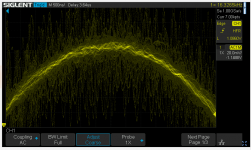
The main issue is when you run/stop as there's no sampled data other than the samples it's got already.
Zoomed into the top of one of those peaks at about 6.15ns:
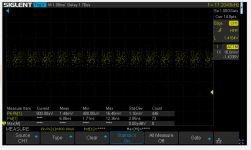
An a software program running as an AWG being controlled for a bode plot of the Mac mini headphone Jack - not massively accurate but free:
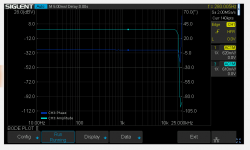
So some direct scope captures on USB sticks attached showing the screen resolution with vectors rather than dots on.
One of the big things you get with a better (and £$€) is a higher resolution screen. I'm not defending the capabilities of the 1104 nor excusing any of speed performance.
We had a £20K+ Keysight in my old job as part of the research work. Massive screen, exceptionally fast update and was quite happy with high speed data across the photo detectors to the FPGAs in realtime.
However if you have a budget at 300-400 then you're really either going to go for a SDS1104X-E or go secondhand from a reputable seller that has calibrated it.
Lastly one - just to show the 8bit depth limit, this on the 1KHz set with 10x probe, you can see the lines of what I assume are the voltage levels on the ADC:
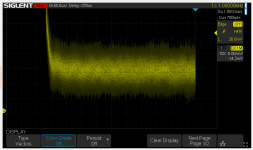
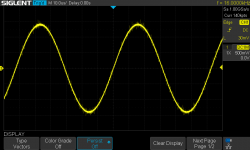
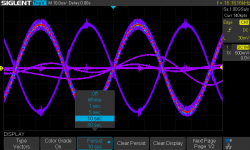
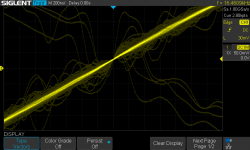
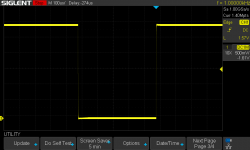
Edit: attachments added as they seemed to disappear from the post.
One of the big things you get with a better (and £$€) is a higher resolution screen. I'm not defending the capabilities of the 1104 nor excusing any of speed performance.
We had a £20K+ Keysight in my old job as part of the research work. Massive screen, exceptionally fast update and was quite happy with high speed data across the photo detectors to the FPGAs in realtime.
However if you have a budget at 300-400 then you're really either going to go for a SDS1104X-E or go secondhand from a reputable seller that has calibrated it.
Lastly one - just to show the 8bit depth limit, this on the 1KHz set with 10x probe, you can see the lines of what I assume are the voltage levels on the ADC:





Edit: attachments added as they seemed to disappear from the post.
Last edited:
Regarding bandwidth: a couple of decades ago I went from a two-channel 20 MHz analogue scope to a two-channel 150 MHz analogue scope and found that the increased bandwidth was very useful for debugging audio DIY circuits.
I remember the first high bandwidth scope I used (at work) and one of the techs commented that you could actually see the raw signal coming from the UHF tuner to the IF strip. I think it was a 30 meg Trio scope but you could just see the signal.
I went from a 5Mhz homebuild (Practical Wireless Purbeck from 1978 ish) to a CROTECH 20 Meg dual beam and then a 100Mhz 'Hung Chang' with comprehensive dual timebase facilities. Even 5Mhz analogue got you a long way in audio and general hobby stuff.
I can zoom in to the top of one of the waves without a problem - the scope will go to 500uV, but I wanted to show the curve of the wave. The screen is better than the web browser screen shot
The main issue is when you run/stop as there's no sampled data other than the samples it's got already.
Zoomed into the top of one of those peaks at about 6.15ns:
An a software program running as an AWG being controlled for a bode plot of the Mac mini headphone Jack - not massively accurate but free:
So some direct scope captures on USB sticks attached showing the screen resolution with vectors rather than dots on.
I find it a bit difficult to visualise without actually having had a play with one. Images like those are really useful though.
What should we advise the op to get do you think (assuming he wants digital)? The Siglent 1104 looks very decent but maybe exceeds the budget.
What should we advise the op to get do you think (assuming he wants digital)? The Siglent 1104 looks very decent but maybe exceeds the budget.
It's a bit of a chicken and egg - without having a scope the OP may find themselves needing a reference point before they can make a decision.
My decision process went:
* I'm a DIYer and this is a hobby - I have a few projects I want to build and I want to continue building.
* I need something for audio frequencies
* I want to be able see DSD at 24MHz for later projects so 200-250MHz
* I have a small amount of space - desk and shelf storage
* Budget was 300ish but I had some birthday money
I looked at the 1202x-e, the 1104x-e and the 1104x-u:
* 1202 has 2ch at 200Mhz but no options for Bode plotting and the firmware is not updated as much as the 1104.
* 1104x-u has a crippled and new front end, it looses the 200Mhz option and looses the 500uV option.
* 1104x-e can be be de-castrated and run at 200MHz, has bode plot, goes to 500uV and reviewed better than the Rigol and others (HanTek etc) although it has some gotchas with sample memory depth, it can run like the 1202 with 500MSps with two probes (just in CH1 and CH3). It also has some handy I2C and CANBUS decode thrown in too (for pond sensor projects) using probes.
So it quickly became a choice of which Siglent rather than which manufacturer - the 1104X-E then simply crossed all the boxes, with the options for 200MHz, Bode etc became a winner.
So as a value for money - does it really solve the OP's problems, quite probably - although Tom's point about learning scope skills using an analogue are valid, there's both the size (or use a small portable analogue Tek for example) and that the Digital also has it's own skills (ie pitfalls).
Hi,
the Keysight´s most prominent lack of something is its poor memory endowment.
1Mpts and less is insufficient memory for a modern device that puts the word ´storage´ in its name, imho.
See the Video what big memory is useful for.
At the eevblog its also told that Keysight still sells their lowend stuff to anybody who asks, but recently have stopped service for everyone not signing in to KeysightCare, i.e. You pay for everything, even for simple small requests.
When the low-end devices of A-Brands are already inferior or alot costier than those of ambitioned chinese manufacturers and(!) they start to reduce or even refuse service to the end customer ... is there a single reason left to buy from them?
Same as Nick I can recommend the Sigent SDS1104X-E.
Its quite responsive and easy/intuitive to handle.
Its enormously capable for its price tag and has loads of functions included (or included after´upgrading´).
A very responsive webserver is integrated.
You can control the scope from a PC and display its data on a large Monitor almost in real-time.
Siglent is known to provide for firmware updates and adding functionalities rather faster and more often than any other manufacturer.
Yes, the price tag may be just on the rim of what a beginner might want to invest, but then .... good tools allow for good results ... and buying cheap means buying twice.
Btw. if You look at TeledyneLeCroy .... most of their entry-range devices come from Siglent. See the T3DSO1104 at almost twice the price.
So obviously Siglent stuff is good enough for A-Brand level 😉
jauu
Calvin
the Keysight´s most prominent lack of something is its poor memory endowment.
1Mpts and less is insufficient memory for a modern device that puts the word ´storage´ in its name, imho.
See the Video what big memory is useful for.
At the eevblog its also told that Keysight still sells their lowend stuff to anybody who asks, but recently have stopped service for everyone not signing in to KeysightCare, i.e. You pay for everything, even for simple small requests.
When the low-end devices of A-Brands are already inferior or alot costier than those of ambitioned chinese manufacturers and(!) they start to reduce or even refuse service to the end customer ... is there a single reason left to buy from them?
Same as Nick I can recommend the Sigent SDS1104X-E.
Its quite responsive and easy/intuitive to handle.
Its enormously capable for its price tag and has loads of functions included (or included after´upgrading´).
A very responsive webserver is integrated.
You can control the scope from a PC and display its data on a large Monitor almost in real-time.
Siglent is known to provide for firmware updates and adding functionalities rather faster and more often than any other manufacturer.
Yes, the price tag may be just on the rim of what a beginner might want to invest, but then .... good tools allow for good results ... and buying cheap means buying twice.
Btw. if You look at TeledyneLeCroy .... most of their entry-range devices come from Siglent. See the T3DSO1104 at almost twice the price.
So obviously Siglent stuff is good enough for A-Brand level 😉
jauu
Calvin
It's a bit of a chicken and egg - without having a scope the OP may find themselves needing a reference point before they can make a decision.....
That's a clear well reasoned post

Available direct from Siglent I see:
Siglent SDS1104X-E Super Phosphor Oscilloscope
Lets wait and see what poundy thinks of it all. It is a lot to take in for someone just starting out but worth getting it right I think.
That's a clear well reasoned post
Available direct from Siglent I see:
Siglent SDS1104X-E Super Phosphor Oscilloscope
Lets wait and see what poundy thinks of it all. It is a lot to take in for someone just starting out but worth getting it right I think.
I bought mine through them - recommended. Originally I had Saturday delivery by accident, an email later and it was in the post for delivery the next day.
Hi,
At the eevblog its also told that Keysight still sells their lowend stuff to anybody who asks, but recently have stopped service for everyone not signing in to KeysightCare, i.e. You pay for everything, even for simple small requests.
Even when it's under warranty?
Even when it's under warranty?
Point of law, so I suspect it's more technical answers and advice on using it. Once they have your money.. and the thing is working to sold specification, they don't see you a loyal customer/relationship. I'd have expected at least a forum where they could collate Q&A (cost in policing it) but they would prefer to charge you for professional consultancy or professional training courses.
Point of law, so I suspect it's more technical answers and advice on using it. Once they have your money.. and the thing is working to sold specification, they don't see you a loyal customer/relationship. I'd have expected at least a forum where they could collate Q&A (cost in policing it) but they would prefer to charge you for professional consultancy or professional training courses.
Well, servicing/ repairing and technical advice are two different things. Although this sucks, I can see how they can be busted with emails from people all over the word asking relevant and irrelevant questions and having to employ people just for this task. Still sucks though. A forum would be a good solution
Used analog's are worth considering. I bought a Tek 2236 some 20 years ago for less than 100$. After a good bath with contact cleaner, it's been working flawlessly ever after.
I have 6 analog scopes and 5 DSO's. My Siglent 1104X-E is the one on the bench that sees use but I have a two input tablet DSO that has been useful ($150) and a one input DSO ($75) that I use a lot despite the 2" screen because its small and battery powered. Its really handy. The big Tek's come out for specific issues (TDR, curve tracer etc.) but as a troubleshooting device I have mostly migrated.
The current versions of the cheap ones above:
$86 https://www.amazon.com/Mivofun-Osci...R,B094VF893P,B09B3PP2BD,B094J7CNVQ,B08D3X8G8N
$149 https://www.amazon.com/YEAPOOK-ADS1...R,B094VF893P,B09B3PP2BD,B094J7CNVQ,B08D3X8G8N
The current versions of the cheap ones above:
$86 https://www.amazon.com/Mivofun-Osci...R,B094VF893P,B09B3PP2BD,B094J7CNVQ,B08D3X8G8N
$149 https://www.amazon.com/YEAPOOK-ADS1...R,B094VF893P,B09B3PP2BD,B094J7CNVQ,B08D3X8G8N
As I work in analogue audio, I'd say that my ideal scope would be an analogue one, but with the various measurement and storage functions that you'd get with a digital one! I have both types next to each other. 99% of the time, my daily driver is the digital. But there are occasions where only analogue will do (I presume an extremely expensive digital one might do as well). Update rate is your enemy on digital, particularly budget scopes. An analogue scope will enable you to see some transient events in real-time, without having to resort to using one-shot storage. In realtime monitoring, a digital might miss these transients altogether due to update rate / lag.
If there are spurious or jittery artefacts present in an analague signal, this can make some tasks almost impossible with a digital scope. For example: if you work with analogue tape machines, an analogue scope is a must.
I’m not very experienced but the above sums up my experience.
Get both, second hand, is my advice.
I have a Phillips analogue and digital switchable scope and a tektronics digital scope. I use both as they both give different information, as Mooly says.
I would make space for them, as having both is so useful.
First scope you should be acquiring these days is a digital scope, if you can afford a decent one. IMO, the Siglent SDS1202X-E is a good starting point. It's got a decent enough 200 MHz front-end, 1 GS/s sample rates, and a really useful 500 uV/div setting. It's less than $400.
For most things these days, digital scopes are more useful. 10 years ago, a sub-$500 digital scope was pretty miserable to use. That's no longer the case.
Now, you should still try to have a good analog scope in your lab, if only because they can actually do XY mode properly, something that digital scopes generally suck at. They're also a little easier for quick troubleshooting of a circuit.
If you're on a tight budget, picking up a used analog scope for $50 or so isn't a bad move. You can still do a lot of good work with one, especially when it comes to audio. But I wouldn't suggest spending a bunch of money to get a 2465 as your first scope.
For most things these days, digital scopes are more useful. 10 years ago, a sub-$500 digital scope was pretty miserable to use. That's no longer the case.
Now, you should still try to have a good analog scope in your lab, if only because they can actually do XY mode properly, something that digital scopes generally suck at. They're also a little easier for quick troubleshooting of a circuit.
If you're on a tight budget, picking up a used analog scope for $50 or so isn't a bad move. You can still do a lot of good work with one, especially when it comes to audio. But I wouldn't suggest spending a bunch of money to get a 2465 as your first scope.
Just to recap as we've had a lot of discussion and a lot of information. To summarise.
Oscilloscope - important points:
For digital
Think of it as a microscope - trading speed vs 8bit resolution of each sample
* samples/sec - this gives the X resolution. Tom's 2 Gigasamples/sec (samples are 8bits after the analogue adjustments/scaling the scope provides) gives a better time-based resolution for example but with that resolution it requires more memory depth. Note some scopes architectures share multiple ADCs thus channel = 1Gsps, 2ch= 500Msps, 3/4ch=500Msps. Cheaper scopes may use one ADC for all channels (hence 1ch=1G, 2=500M & 3/4=250M), more expensive scopes may offer full Gsps per channel.
* sample depth - this is the bits per sample and essentially gives you the Y scale (voltage) resolution. This is after the analogue preprocessing - so the "zoom" etc is typically done in analogue then offered to the sampling ADC so that 8bit only really becomes an issue over large ranges or where the small signal vs noise level is concerned.
A scope is fast rate sample rate but lower accuracy, whereas a audio analyser is low (Kilosamples/sec or less) but typically offers 24bit samples.
* bandwidth - this is quoted frequency the scope can honestly evaluate. Note you will be able to see higher but you will see a frequency rolloff. What is important is a square wave needs it's sum of higher frequents to be accurate, thus you will need at least 5x the bandwidth of the highest signal you want to measure - that includes detecting high frequency oscilations and noise outside of the 1-20KHz. Remember the scope is a microscope so you want to see more detail.
* Trigger - most digital scopes seem to use a digital trigger. This has benefits and drawbacks - a benefit is that with processing power and sample memory, sample rate and bit-dept, the triggering can fire based on some very complex digital criteria and not just a simple voltage line. The drawback is: unless that signal you've set to triggering on is within the current ADC range after the scope analogue processing (ie zoomed in = zoomed in trigger). This is why the ADC and channels architecture is also important - samples/sec offers the resolution of the trigger too. So if you're completely zoomed in and finding the triggering difficult, then running a separate channel on the same signal (with a 1/2 sample rate penalty) means you can trigger on a wider part of the waveform (or even a completely different criteria) This is where you start seeing the sample rate/ADC vs channel tradeoff whereas on an analogue scope you have a full range (and only noise or scope design limits your resolution).
* memory depth (and speed of processing) - a digital scope needs somewhere to put all those samples before it's displayed. So sample memory and how the scope features use the sample memory is important but overall more/faster memory depth is good.
If you Run/Stop (ie pause the signal) then the memory depth plays a part where you can zoom around (although you will be limited by samples and bit-depth). The memory is also used for triggering processing so a slow memory processing means less triggering performance. Lastly your analysis and maths functions also work on memory so FFTs, averaging, and digital decoding of signals, need both memory depth and the processing power to keep up with the sample rate (no point having massive memory depth if either the sample rate or processing power to analyse can't keep up).
The maths functions allow you todo things like differential voltage measurements, FFTs whereas 'measurement' features allow you to see peaks/averages and variation for samples. The 1104 allows you to record triggered waveforms as a history and search through them. This allows you to setup triggers and see the history of waveforms leading up to an event over time.
I would also add UI being an important point - given you don't have a keyboard and mouse, it helps that the menu options are thought out and the controls work consistently. There's some 'undocumented' features on the 1104, using the adjust knob allows you to open a box to type in values. What isn't documented is that the trigger knob allows you to move the cursor in an Y direction where the adjust is in the X/wraparound. Little things make it faster to work with - adding the web server means you can use your PC keyboard and mouse.
The display of a digital scope is important - not only the fidelity but also how the scope brings that data to you. A digital scope sees data or it doesn't see data there is no middle ground. That means where as an analogue scope you may be blissfully unaware due to CRT brightness or lower bandwidth, a digital scope will give you everything it sees. Information overload - which is good but needs the features to help a human navigate through it but also requires the understanding there's holes in that information (between samples, resolution etc).
From my limited analogue experience - for me an analogue scope gives the better screen appearance from a resolution perspective. The CRT phosphor acts as a natural filter and smooths. An analogue scope offers closer to what a audio analyser resolution offers but the analogue filtering that is distinctly human (well it is human).
I will leave the others to detail analogue scopes.
In the end the OP will end up with:
* one or more scopes
* an audio analyser (PC based device)
* an arbitrary waveform generator
* a good voltmeter or three - voltage, current, resistance and capacitance, possibly inductance but in circuit a scope can show you what is getting through
* capacitor leakage tester
* probes to suit - passive, high voltage and differential depending on the work. The 1104 have 300V probes hence 100x or 1000x (ie 600V-1KV) for tubes.
* tube tester
Doh. I started out thinking a brief summary would work. I need to re-educate myself on the meaning of 'brief' 😀 Personally - I went digital. It solves my problems. I'm happy that I did, although I would love an analogue scope - space and spousal appeasement means it's not going to happen.
Oscilloscope - important points:
For digital
Think of it as a microscope - trading speed vs 8bit resolution of each sample
* samples/sec - this gives the X resolution. Tom's 2 Gigasamples/sec (samples are 8bits after the analogue adjustments/scaling the scope provides) gives a better time-based resolution for example but with that resolution it requires more memory depth. Note some scopes architectures share multiple ADCs thus channel = 1Gsps, 2ch= 500Msps, 3/4ch=500Msps. Cheaper scopes may use one ADC for all channels (hence 1ch=1G, 2=500M & 3/4=250M), more expensive scopes may offer full Gsps per channel.
* sample depth - this is the bits per sample and essentially gives you the Y scale (voltage) resolution. This is after the analogue preprocessing - so the "zoom" etc is typically done in analogue then offered to the sampling ADC so that 8bit only really becomes an issue over large ranges or where the small signal vs noise level is concerned.
A scope is fast rate sample rate but lower accuracy, whereas a audio analyser is low (Kilosamples/sec or less) but typically offers 24bit samples.
* bandwidth - this is quoted frequency the scope can honestly evaluate. Note you will be able to see higher but you will see a frequency rolloff. What is important is a square wave needs it's sum of higher frequents to be accurate, thus you will need at least 5x the bandwidth of the highest signal you want to measure - that includes detecting high frequency oscilations and noise outside of the 1-20KHz. Remember the scope is a microscope so you want to see more detail.
* Trigger - most digital scopes seem to use a digital trigger. This has benefits and drawbacks - a benefit is that with processing power and sample memory, sample rate and bit-dept, the triggering can fire based on some very complex digital criteria and not just a simple voltage line. The drawback is: unless that signal you've set to triggering on is within the current ADC range after the scope analogue processing (ie zoomed in = zoomed in trigger). This is why the ADC and channels architecture is also important - samples/sec offers the resolution of the trigger too. So if you're completely zoomed in and finding the triggering difficult, then running a separate channel on the same signal (with a 1/2 sample rate penalty) means you can trigger on a wider part of the waveform (or even a completely different criteria) This is where you start seeing the sample rate/ADC vs channel tradeoff whereas on an analogue scope you have a full range (and only noise or scope design limits your resolution).
* memory depth (and speed of processing) - a digital scope needs somewhere to put all those samples before it's displayed. So sample memory and how the scope features use the sample memory is important but overall more/faster memory depth is good.
If you Run/Stop (ie pause the signal) then the memory depth plays a part where you can zoom around (although you will be limited by samples and bit-depth). The memory is also used for triggering processing so a slow memory processing means less triggering performance. Lastly your analysis and maths functions also work on memory so FFTs, averaging, and digital decoding of signals, need both memory depth and the processing power to keep up with the sample rate (no point having massive memory depth if either the sample rate or processing power to analyse can't keep up).
The maths functions allow you todo things like differential voltage measurements, FFTs whereas 'measurement' features allow you to see peaks/averages and variation for samples. The 1104 allows you to record triggered waveforms as a history and search through them. This allows you to setup triggers and see the history of waveforms leading up to an event over time.
I would also add UI being an important point - given you don't have a keyboard and mouse, it helps that the menu options are thought out and the controls work consistently. There's some 'undocumented' features on the 1104, using the adjust knob allows you to open a box to type in values. What isn't documented is that the trigger knob allows you to move the cursor in an Y direction where the adjust is in the X/wraparound. Little things make it faster to work with - adding the web server means you can use your PC keyboard and mouse.
The display of a digital scope is important - not only the fidelity but also how the scope brings that data to you. A digital scope sees data or it doesn't see data there is no middle ground. That means where as an analogue scope you may be blissfully unaware due to CRT brightness or lower bandwidth, a digital scope will give you everything it sees. Information overload - which is good but needs the features to help a human navigate through it but also requires the understanding there's holes in that information (between samples, resolution etc).
From my limited analogue experience - for me an analogue scope gives the better screen appearance from a resolution perspective. The CRT phosphor acts as a natural filter and smooths. An analogue scope offers closer to what a audio analyser resolution offers but the analogue filtering that is distinctly human (well it is human).
I will leave the others to detail analogue scopes.
In the end the OP will end up with:
* one or more scopes
* an audio analyser (PC based device)
* an arbitrary waveform generator
* a good voltmeter or three - voltage, current, resistance and capacitance, possibly inductance but in circuit a scope can show you what is getting through
* capacitor leakage tester
* probes to suit - passive, high voltage and differential depending on the work. The 1104 have 300V probes hence 100x or 1000x (ie 600V-1KV) for tubes.
* tube tester
Doh. I started out thinking a brief summary would work. I need to re-educate myself on the meaning of 'brief' 😀 Personally - I went digital. It solves my problems. I'm happy that I did, although I would love an analogue scope - space and spousal appeasement means it's not going to happen.
Last edited:
well i guess for a new one about £400
i also noticed that the new ones dont come with any leads so i would need to know what else i would need.
thanks
Good point - on probes..
The 1202X comes with two passive 600V 200MHz probes and the 1104 comes with four 100MHz 300V probes. Although I would probably err on the side of caution with any bundled probes with voltages over 200V in favour of a specialist probe. The bundled 1104X-E probes are good for 200MHz use.
The 1104X-E front ends are "15pF, 1Mohm,400Vpk". So new probes you purchase will need to be compatible in terms of capacitance and termination or you'll have skewed measurements and the probes will not calibrate a square wave properly.
1M ohm termination is pretty much standard with most low end scopes, the more expensive scopes the scope offers additionally selectable 50 ohm and even 75 ohm for use with impedance matched transfer. It's possible to use an external BNC probe impedance adaptor.
Design/build vs trouble shoot tend to start differently - a multimeter is normally the first call anyway - for HV or LV work. So a good dependable HV-capable multimeter is a god send. Get some crock clip for the probes so you working with only one hand in the chassis. A good multimeter probe kit would sort that. Just makes sure you know the insulation ratings for the kit probes.
If you analysing a signal problem then the scope comes out and even then you're going to spend most of the time on the LV side anyway - input or speaker posts. The inside HV area has some dangers directly (naturally) but even trying a 300V probe on a 50V biased signal can have AC dangers but also should the probe cable get close to a 400V bare piece the 300V insulation then has 400V to ground cable shield across it for example. Or worse that '12.6V heater' is actually referenced to -260Vdc for example. So best stay away from HV amps until you're comfortable with the design and operation of the amps and have the right equipment. Probably until you've fried a few low voltage IC's with probe shorts and accidental multi-probe grounding accidents 😀
Sorry - going off on one #healthandsafety
appreciate all the comments guys.
Im affraid at this stage most of what you have said has gone over my head, but im sure i will pick it up.
As i said earlier, i am learing electronics(slowly) and at the moment i most enjoy the fault finding and repairing aspects, rather than the design and build, although once i get confident enough, im sure ill extend to this.
I was thinking of the below as a starter piece of kit, so please let me know if it is/isnt realy what i need.
I then just heave to learn how to use it🙁
https://uk.rs-online.com/web/p/oscilloscopes/2005279/
or
https://uk.rs-online.com/web/p/oscilloscopes/2024903/
Or i could go with one of the many recommended ones from you guys,but i wouldnt know which one to choose.
I need something, at least to start with that is going to be easy to learn how to operate, and of course understand what i am looking at.
many thanks
Im affraid at this stage most of what you have said has gone over my head, but im sure i will pick it up.
As i said earlier, i am learing electronics(slowly) and at the moment i most enjoy the fault finding and repairing aspects, rather than the design and build, although once i get confident enough, im sure ill extend to this.
I was thinking of the below as a starter piece of kit, so please let me know if it is/isnt realy what i need.
I then just heave to learn how to use it🙁
https://uk.rs-online.com/web/p/oscilloscopes/2005279/
or
https://uk.rs-online.com/web/p/oscilloscopes/2024903/
Or i could go with one of the many recommended ones from you guys,but i wouldnt know which one to choose.
I need something, at least to start with that is going to be easy to learn how to operate, and of course understand what i am looking at.
many thanks
- Home
- Design & Build
- Equipment & Tools
- oscilloscope-Analog or digital